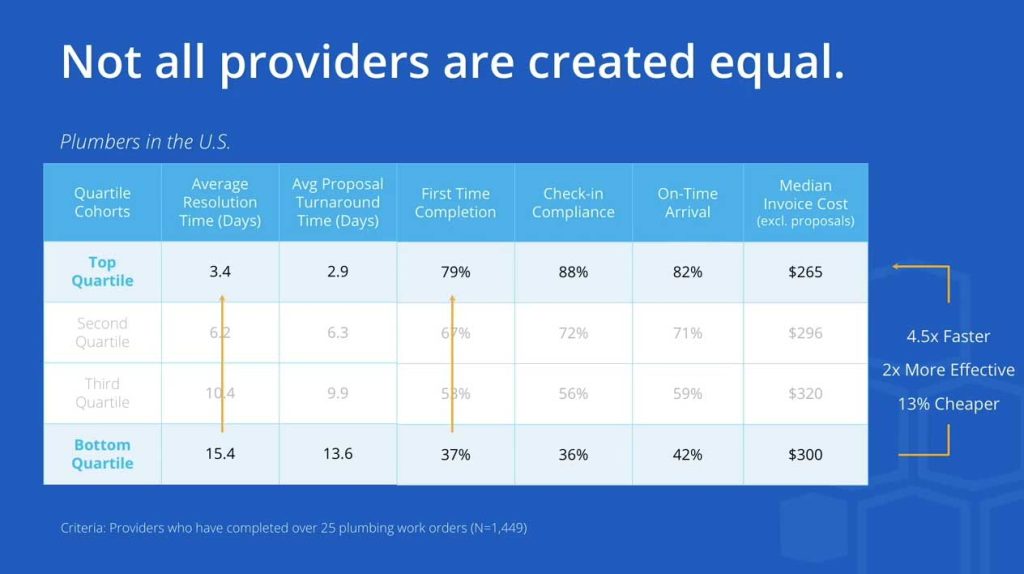What Is a Maintenance Workflow and How Do You Optimize It?

Speed up your repair tasks by assessing and improving your maintenance workflow. Find out how to do that and what to look for.
A maintenance workflow process is a structured sequence of tasks used to identify, report, schedule, and resolve maintenance issues. These tasks include both the communication steps and the steps involved in actually addressing work requests.
Having a defined maintenance workflow is important because it reduces your facility’s risks of scattered communication and inefficient maintenance activities. Both of these risks increase the length of equipment downtime and increase your potential need for costly reactive maintenance.
To be more specific, fragmented communication slows response times and creates confusion about who handles what. This confusion directly contributes to the risk that important maintenance tasks will be missed. Additionally, unclear maintenance steps will make your maintenance personnel slower at their work.
That’s why this guide will explore what you can do to enhance your facility’s maintenance workflow. We will discuss strategies to assess, streamline, and optimize your current operations and show you how and why a tech-enabled strategy improves decision-making.
Key Takeaways:
- Clear maintenance workflows help verify that the expected maintenance activities are performed when they should be
- A maintenance management software tool can assist facility managers in managing maintenance operations
- Integrating your technology tools makes maintenance workflows easier to manage
- A connected maintenance environment will improve operational efficiency, but it does require ongoing performance tracking and regular reviews
How to Assess Your Current Maintenance Workflow Process
Map the Entire Workflow
Document each step involved in your current maintenance process. Consider using flowcharts or diagrams to show which tasks should be performed at which stage. This visual reference provides a baseline for comparison and helps you pinpoint where time is lost or duplicated.
Most maintenance processes will go through the following steps to uphold equipment reliability. Here are the steps involved and the information you must record to maintain accuracy.
1. Work Request Intake
Record who submits the request, how it is submitted, and what information is required at submission. Include timestamps, request categories, and any information that will help direct the request to the appropriate maintenance team.
2. Issue Prioritization
Document the criteria used to determine urgency, such as safety hazards, business impact, or compliance requirements. Take note of who assigns priority levels and whether it is done manually or by a work order software platform.
3. Dispatch
Track how work is assigned, who assigns maintenance activities, and what tools or systems support the process. Include technician availability, skill matching, and assignment logs. Also, record the time between request submission and assignment.
4. Repair
Instruct your maintenance technicians to document start and finish times, work performed, materials used, and any complications that may arise. Use standardized forms or digital checklists to keep records consistent.
5. Follow-Up
Track whether the requester signs off, if a supervisor verifies the repair, and how customer satisfaction is recorded. Also, take note if any issues appear to be repeating themselves across multiple jobs.
The maintenance data that you can gather through proper recordkeeping can reveal a lot of valuable information about what works in your maintenance workflows and what doesn’t. Using work order templates can also help your operators provide better details about their work requests.
Review Work Order Timelines
Examine how long it takes for a maintenance request to move from submission to resolution. If requests sit unassigned or technicians wait on approvals, those lags directly affect uptime. There are a lot of different maintenance metrics that you can use to track these timelines.
Collect Technician Feedback
Ask your maintenance teams where they waste the most time. Look for repeated steps, tool shortages, unclear work orders, or approval delays. Insights from frontline team members can reveal additional information that quantitative data metrics may miss.
Examine Records
While we discussed how to record your maintenance information, you also must verify that the data is accurate and kept up-to-date. Review completed work orders, each asset’s maintenance history, and logs for missing data, vague notes, or inconsistent timestamps.
Evaluate Vendors
Look at how external vendors are managed. Review response times, completion rates, and how issues are reported. Capturing this data helps you compare internal to external work efficiency and spot gaps.
Track Escalation Frequency
Identify how often tasks are escalated to supervisors or beyond the normal workflow. Note the specific maintenance tasks that get escalated the most and how long they remain unresolved. Frequent escalation indicates that there may be issues with the primary process.
Audit Your Preventive Maintenance Program
Compare your scheduled maintenance tasks to what is actually done. Check for inconsistencies and see if there are patterns based on asset, location, team, or individual technician. If found, explore why specific preventive maintenance tasks are not being correctly followed and address the issue based on the discovered reason.
Why Integrating Your Tools and Data Simplifies Maintenance Workflow Processes
Integrating your maintenance software tools and data onto a single platform significantly improves maintenance performance and enhances maintenance management. That’s because maintenance personnel no longer need to jump between systems to check asset status, technician schedules, or job progress.
Instead, they can use integrated CMMS (computerized maintenance management systems), like ServiceChannel, to manage vendor selection, job assignments, and invoice approvals. As a result, every maintenance manager can make decisions faster, which leads to cost savings on work hours and resource allocation.
Some businesses also still depend on legacy tools that were never designed to share data. Replacing them entirely may not be practical, but integration can offer a solution. Integrated analytics connect data from both the old and new systems. That means your facility can still reduce your need for manual tracking and guesswork, even if you are in this situation.
Key Benefits of a Connected Maintenance Environment
Improved SLA Adherence
A unified platform can track work requests, timelines, maintenance costs, and technician performance in one place. Having all of this information on a single platform makes it easier to track where there may be any risks of potential service-level agreement (SLA) violations.
Provider Accountability
One system tracks all maintenance activities, making it easier to identify gaps in technician and equipment performance. This clear evidence trail helps facility managers hold their maintenance teams more accountable.
Reduced Administrative Burden
The same platform handles work orders, approvals, and updates, and it automates manual tasks like sending emails or making phone calls. These features help reduce the amount of paperwork required and lower your risk of miscommunication.
Faster Repair Times
With all information related to any specific maintenance event in one place, repair and replacement procedures happen faster. Team members can save the time they would have spent looking for key details and reallocate that time to their maintenance efforts.
Continuous Improvement and Performance Tracking Tips
Track Resolution Times
Log how long it takes to complete each repair from the time it’s reported to when it’s closed. Watching average repair time helps you identify delays and pinpoint where workflow changes might be needed.
Log Recurring Issues
When the same equipment keeps failing, document every incident and group them by type or location. Repetitive equipment failure may mean inspections are rushed, vendor tasks are incomplete, or internal procedures are being skipped.
Review Your Baseline Standards
Compare your current process to documented routines like checklists, service intervals, and inspection steps. These maintenance essentials demonstrate expectations that you can then compare to actual work to see if anything is regularly missed.
Use KPIs
Key performance indicators (KPIs) can help guide decisions around staffing levels, vendor adjustments, or process changes. The KPIs that matter most to preventive maintenance programs include the following:
- Time to Repair (TTR): How long it takes to complete a repair.
- Cost per Repair: The total maintenance expenses of each repair.
- Failure Rate: The percentage of equipment breakdowns within a set period after scheduled maintenance or a repair.
- Downtime Duration: The total time the equipment is out of service.
- First-Time Fix Rate: The percentage of repairs completed successfully on the first visit.
Hold Team Check-ins
Set time aside for field staff and supervisors to walk through what works and what doesn’t, and verify that maintenance priorities are clear. These conversations often reveal small process gaps that may not be obvious in performance reports.
Follow-Up After Reviews
Each review should lead to practical next steps. A clear follow-up process is needed to ensure maintenance tasks are improved in the future based on evidence. For instance, you may discover a need for more efficient resource allocation to reduce the rate of unattended work requests.
Follow-Up Dos and Don’ts
| Dos | Don’ts |
| Assign a specific person to handle each follow-up action | Leave tasks open-ended |
| Set deadlines for follow-up tasks and track completion | Assume that tasks will get done |
| Use data to decide which adjustments are needed | Repeat the same old steps without applying lessons learned |
| Communicate changes clearly | Make adjustments without notifying your maintenance department |
| Document successful updates and update procedures | Rely solely on memory or informal handoffs |
| Revisit past follow-ups during future reviews | Treat each review as an isolated event without connecting it to past outcomes |
Optimize Your Maintenance Workflow Process with ServiceChannel
ServiceChannel gives facilities one platform to manage work orders, preventive maintenance, vendor performance, and spending. The system provides real-time tracking, automated scheduling, and clear reporting, so your team leaders can make decisions based on accurate information.
As a result, it is much easier to analyze maintenance costs, create a maintenance schedule, and ultimately enhance your maintenance workflow processes. Our CMMS software includes maintenance workflow automation features that let your team assign work orders faster, prioritize critical assets, monitor vendor performance, and reduce delays.



